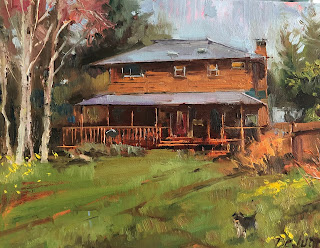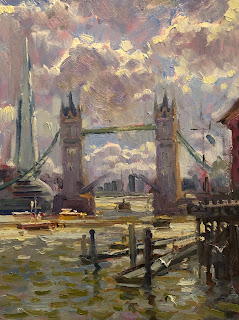Recently I've become (yet another) groupie of Steven Pinker and his work. He is a Canadian-American cognitive psychologist, linguist, and popular science author. While reading his book "The Blank Slate", a defense of innate traits in the human mind, I started to think his ideas might apply to our notion of art and sure enough, Chapter 20 was devoted to just that. I found this chapter fascinating even if it wasn't exhaustive. In a nutshell, the human race has carried art in our bones since we developed human bones and advances in neurology, genetics and psychology indicate we have an innate need -and talent- for art.
 |
| Glen Namundja at work. |
To paraphrase Robert Storey, art has three voices, those of the author, the audience, and the species.
Pinker starts his chapter by pointing out that critics, scholars and people who make al living in the arts lament the loss of an interest in high culture. They point out that the National Endowment for the Arts has seen its budgets slashed and that Universities are dropping Humanities courses at a quick pace. Museums rely on blockbuster shows to survive and orchestras have to fall on classics or popular music fro their funding.
These complaints are anything but new.
And yet, there has never been more art available or produced, ever, EVER.
 |
| Nawarla Gabarnmang, Australia. Paintings that predate Stonhenge. |
Pinker does admit a decline in three areas that descend from prestigious European genres: 1) music performed by symphonic orchestras, art shown in major galleries and museums, and the ballet performed by major companies. Quick, name a classical music composer born after 1940. They are all probably in the film business. 2) Art criticism and its loss of influence. 3) Arts Academia, a favorite subject in satirical novels - a veritable genre - , comedies and even zany movies.
Steven Pinker gives a totally plausible explanation for this decline. Nothing to do with 'eurocentrism' or a lack of education in the audiences or a decline in the cultural prowess of the West or any of the other bored and tired explanations from the right and left. More about this later.
While working on a particularly repetitive stretch of shots for a children's television series I was able to listen to "Homage to Catalonia" from George Orwell on Youtube and a commentary on Ben Jonson's "Volpone", a Jacobean play. I also listened to "Niebla" , a novel by M. De Unamuno. My husband was simultaneously watching "Hamilton" for the nth time on Disney+ streaming service.
It might seem that all we get is mass-appeal for-profit adaptations of tried and proven formats, violent or sex-soaked films and commercial garbage. Bookstores are brimming with celebrity esposés but, to anyone awake, there are a lot of excellent movies, plays and songs being written -right now- if you care to look for them. Same with everything else, novels, paintings, graphics, dance, music and videogames. To quote Pinker: "We are swimming in culture, drowning in it" (...) "Carla on Cheers was wittier than Dorothy Parker, and the plot of Tootsie is cleverer than the plots of any of Shakespeare's cross-dressing comedies." he writes.
The reason why the best works of are more likely to have appeared in past decades is because there has been an inevitable necessary filtering over time. It is hard to recognize the hits and the significant while it is still in its embryonic state. By the time a piece of art is widely recognized as such, the artist might not even be around to enjoy the benefits (which is a great motivation for artists to stay alive), by the time it has become 'popular', its best days, those of relevance and illumination, are usually over. To put down the present is a way to putting down one's rivals. "Competition of praise inclineth to a reverence of antiquity. For men contend with the living, not with the dead." -Hobbes
"In or about December, 1910, human nature changed" said Virginia Woolf. She was referring to the new philosophy of modernism. Pinker makes the opposite point,that the elite arts, scholarship and criticisms are in trouble because human nature -in reality- hasn't changed.
Despite obvious differences and emphasis, every culture has produced art. Denis Dutton identifies seven universal signatures that define art in every culture and time.
1) Expertise or virtuosity. Technical artistic skill.
 |
| Median (Iran) Gold Rhyton . 6-7th BC. Skills are evident. |
2) Nonutilitarian pleasure. You enjoy it for art's sake. It's not material whether it contributes to a particular use or not.
 |
| Navajo Blanket. DeYoung Museum. Just as warm without the patterns. |
3) Style. The object or composition satisfies rules that make it recognizable as part of an art type.
 |
| Page from "Akira" comic, manga style. |
4) Criticism. People make a point of judging, appreciating and interpreting works of art. Art should be open to everyone's commentary unlike ,say ,construction codes where experts opinions carry a lot more weight. Art that is "beyond" criticism and retired by force from the discussion becomes something else, propaganda mostly, and its aesthetic and imaginative force may be neutered by the lack of options. An "official" artist, that is an artist sponsored by a state or a religion or a group is more official than artist in the short run. Some artists court controversy for controversy's sake -where allowed of course-, to force a social criticism that gets confused with one of arts' regular attributes.
5) Imitation. With a few exceptions like music and abstract art, artworks simulate experiences of the world. I would also argue abstraction and music somehow jive with neurological pleasure centers that reflect real world stimuli. Representation of something else, as in a map or a croquis of a construction plan, is a common human trait. This doesn't mean that art should tend to total simulation of the real world, that is just a choice of the artists and dependent on her abilities. The reference to the real world does not require perfect verisimilitude as this is an impossible task. The arts have a myriad tools at their disposal to enhance and bring attention to the expression of physical and emotional perceptions.
6) Special focus. Experience of art is bracketed from ordinary life. Singing in the shower or while working is different from the communal experience of a performance. Frames, galleries, stages, pedestals, altars... the performative aspects of art require spaces and rituals to alert us to the difference. When a cleaning crew mistakenly sweeps away a pile of sand/rags left in a gallery floor confusing it with rubbish, the cleaners simply did not make such distinctions, the gallery is their work space and the banal aspects of the art, no skill, no use, no imitation of anything, don't contribute to its distinction. But it has been proven that sometimes top-notch musicians get no attention if they play in a NYC subway station. The art itself might simply not be striking or fast enough to create the special focus in a one hit.

Hugo Marchand. Opera de Paris Ballet.
7) An imaginative experience. Art is raised from the mundane by an act of imagination. Imagination itself can be used for all sorts of purposes, planning, solving problems... but this is where art happens as well.

Beatrix Potter. Children's book illustration. 1901






















































